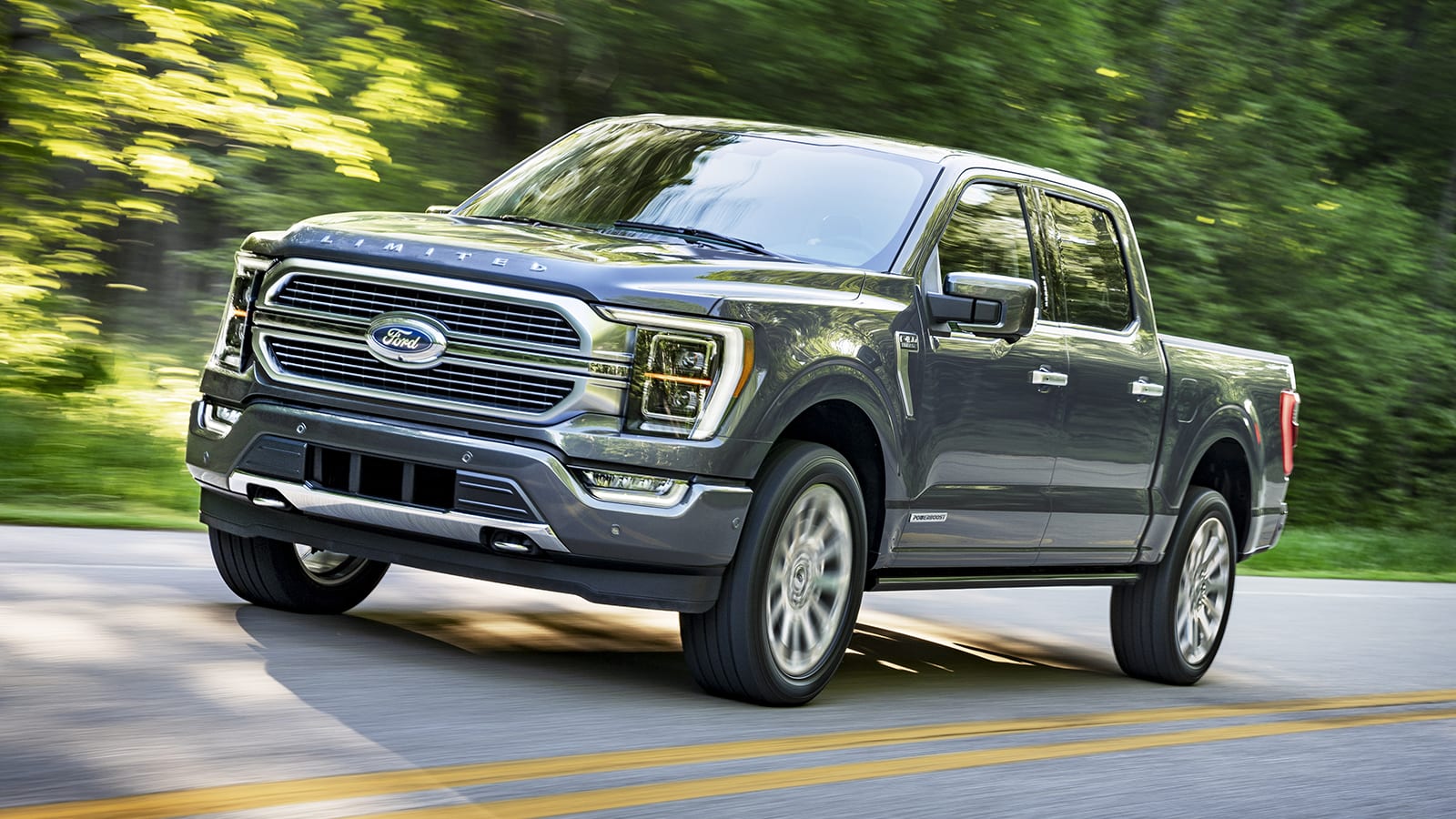[ad_1]
Pros: Exceptional powertrains, including the hybrid and Lightning; unique and game-changing tech; well-balanced driving dynamics; Raptor!
Cons: Interior design is a bit ugly; the Ram rides better
As you can see from the rather “yeah, so what?” collection of cons above, it’s safe to say that we think that buying a 2023 Ford F-150 would be a decent idea. We might prefer driving the Ram 1500 or sitting in the Chevy Silverado’s stylish new interior, but when it comes to those things that make a truck a truck, the F-150 is quite simply exceptional.
It really comes down to two big-ticket areas: engines and technology. First, its smooth and efficient turbocharged V6 “EcoBoost” engines provide impressive refinement and power that makes anything with a V8 feel a bit old fashioned. Of course, the PowerBoost Hybrid puts even those to shame with the sort of no-compromise combo of power and efficiency that can really only be beat by the also-exceptional F-150 Lightning electric truck we review separately.
Second, when we talk about “technology” we’re not talking about the usual discussion of touchscreens and Apple CarPlay. Nope, the F-150 has game-changing tech for actual truck purposes. We named its Pro Power on-board generator options our Technology of the Year for 2021, and then its Onboard Scales and Smart Hitch hauling and towing features our Technology of the Year for 2022. We describe them at the above links and below.
For everything else that makes a truck a truck, including a variety of off-roading options topped off by the wild new Raptor R, the F-150 delivers. Try out the Ram and GM trucks to be sure, but definitely don’t ignore this Ford.
Interior & Technology | Passenger & Cargo Space | Performance & Fuel Economy
What it’s like to drive | Pricing & Trim Levels | Crash Ratings & Safety Features
What’s new for 2023?
Besides massively jacked up prices, there’s another pair of off-road-oriented F-150 models for 2023. First, there’s the Rattler, a package that adds to the base XL trim level a variety of FX4 package upgrades: skid plates, all-terrain tires, off-road shocks, a locking diff and hill descent control. Outside you can tell it apart from the unique combination of XL black plastic grille and bumpers paired with special badging and the rugged wheel/tire combo. Second, there’s the Raptor R, which adds a supercharged V8 to more or less the same Raptor chassis upgrades. You can read all about it in our Raptor R first drive review. There’s also the F-150 Heritage Edition that pays tribute to the marque’s history of distinctive two-tone color schemes. They’re pretty snazzy.
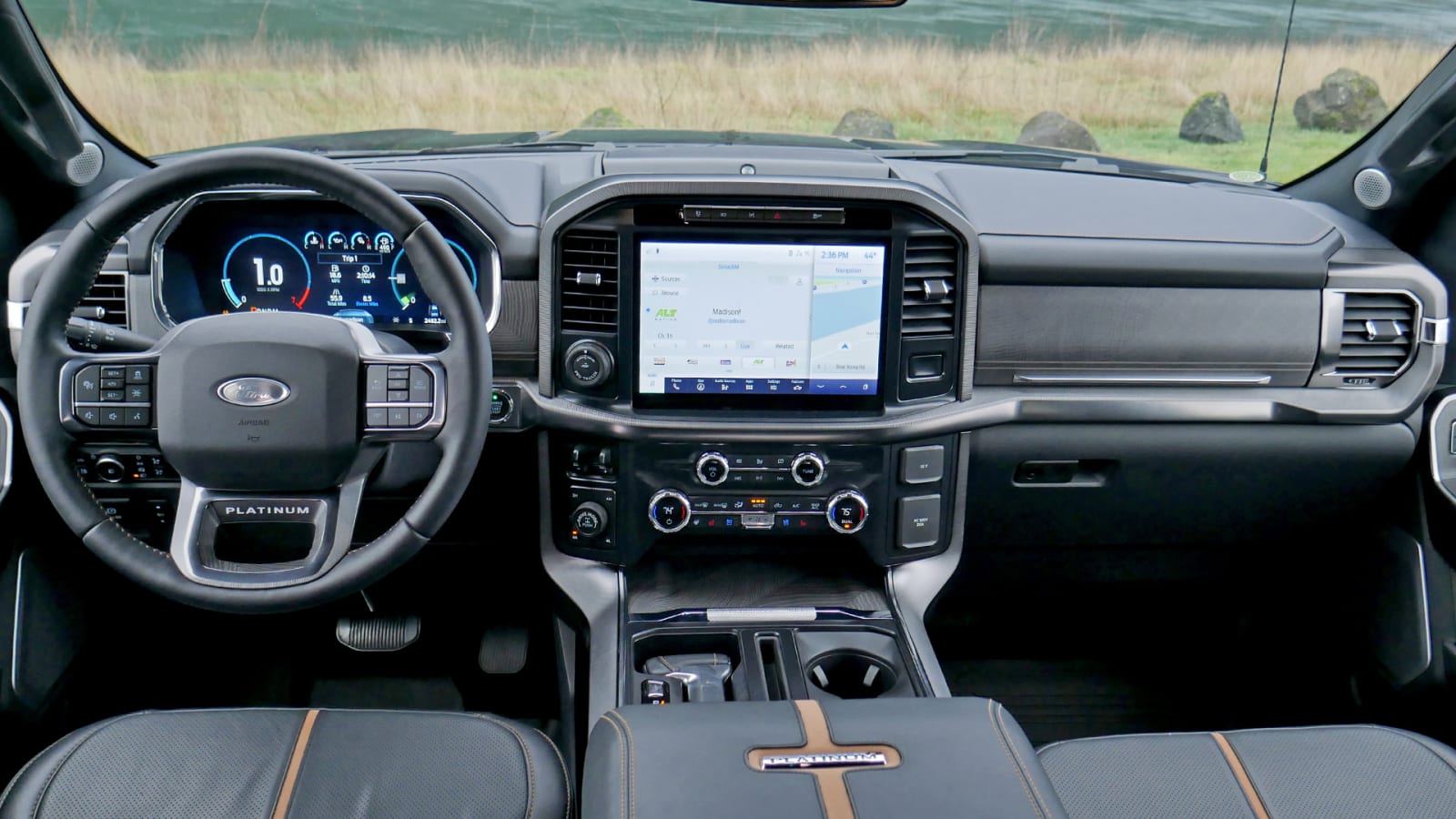
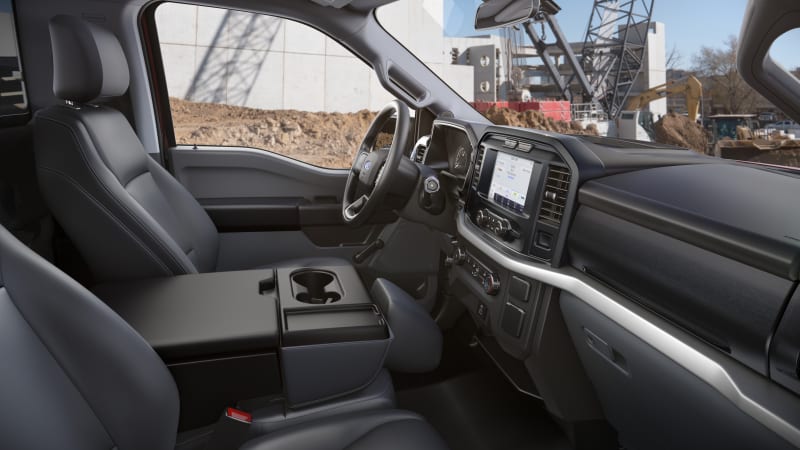
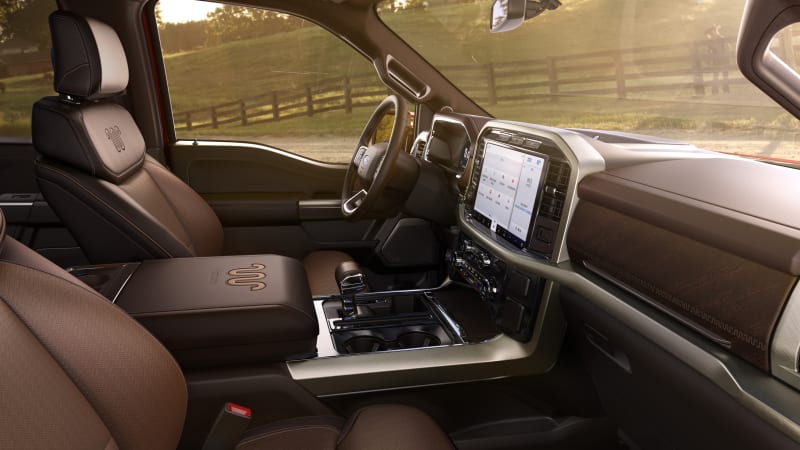
What are the F-150 interior and in-car technology like?
Ford performed major surgery on the F-150’s dash two years ago in order to swallow what is essentially a small television in top trim levels. The result is an awfully monolithic center stack that’s less visually appealing than what you’d get in the Ram 1500 and radically revised Chevy Silverado and GMC Sierra. That’s especially true when talking about the upper trim levels, but at least those including the Platinum (pictured top) make up for it with buttery leather, open-pore wood trim and nicely textured metal-look trim. That said, even the lower XLT trim has high-quality materials and the novel inclusion of a trim piece embossed with a map of Detroit (pictured below, bottom left)
As for that big 12-inch screen, we can’t say it adds much to the Sync 4 interface beyond simply being bigger than the 8-inch standard unit. That’s certainly still a benefit (who wants a smaller screen?), but unlike the Ram portrait-style upgrade and GM’s widescreen unit (plus the Lightning’s portrait-style Sync 4A screen), the larger screen doesn’t maximize its extra acreage with rearranged or extra-large icons that greatly improve functionality. It’s also a further reach than what you’ll find in the Ram, regardless of screen size. On the other hand, the available all-digital instrument panel is colorful and crisp, and there’s no faulting the ample infotainment feature content.
We extensively reviewed the six-passenger cabin of a F-250 SuperCrew whose seating is essentially shared with the ’22 F-150, including its front middle seat and fold-down console. Five-passenger F-150s, meanwhile, offer a center console with a unique armrest lid that unfolds forward to become a flat surface to place a laptop, paperwork or road-side picnic. To make this origami possible, the shifter uniquely motors forward into a recess, though only when parked (pictured below). We’re curious to know how much owners have actually utilized and appreciated this functionality. Ford also greatly increased the steering wheel’s tilt and telescoping travel, making for an impressively more comfortable, SUV-like driving position.
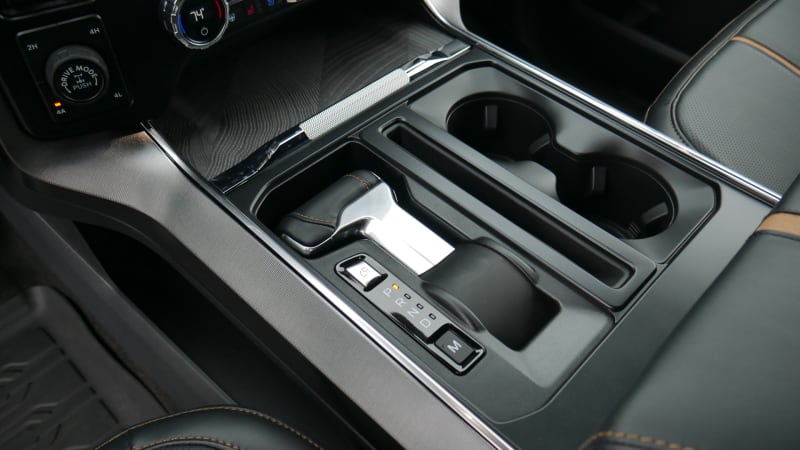
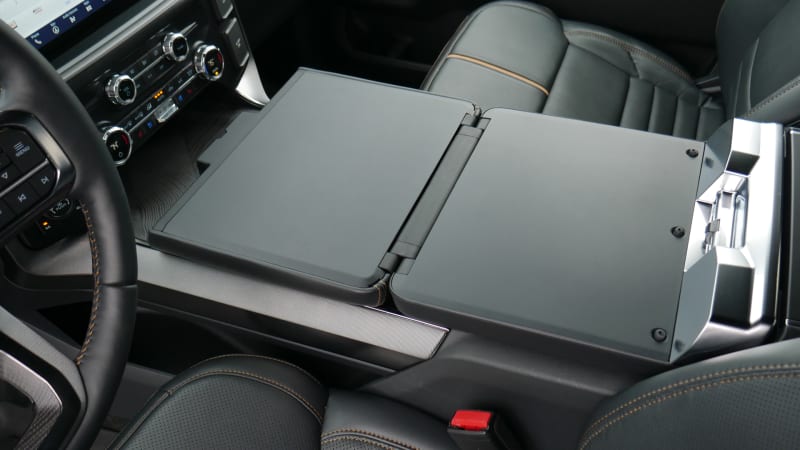
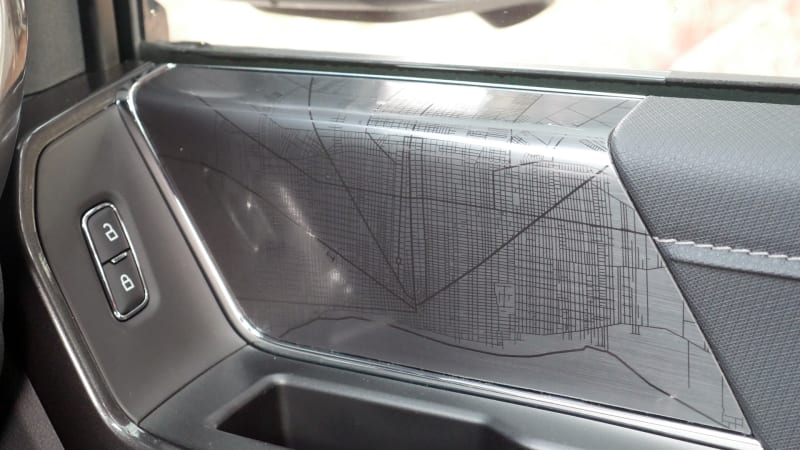
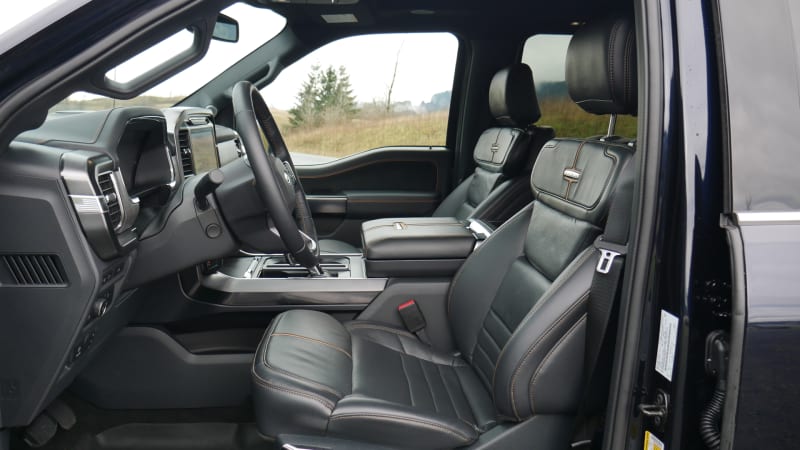
How big is the F-150?
The various full-size trucks are so big that differences among them are effectively moot. An inch or two here and there won’t make a difference outside. As before, you get a choice of regular, SuperCab (extended) and SuperCrew cabs with the latter two offering six-passenger or five-passenger seating arrangements. The SuperCab continues to have clamshell doors rather than the front-hinged ones offered by Ram and GM. Its back seat space continues to be on the cramped side, but that’s common for the segment. So too is the vast amount of rear seat space in the SuperCrew.
This is also as good a place as any to mention the F-150’s unique bed elements. One is familiar: the tailgate’s pop-out assist step that makes repeatedly climbing up and down out of the bed a game-changing quick-and-easy process (pictured above right). The second is a more recent advancement: the ProPower On Board electrical system that allows the F-150 to function as mobile generator and power station. A 2.0-kilowatt system is optional with the 2.7-, 5.0- and 3.5-liter gas engines, while the Power Boost hybrid offers a choice of standard 2.4-kW or optional 7.2-kW outputs. The lower-powered systems have a pair of 120-volt 20-amp outlets (pictured below left), while the 7.2-kW system adds two more 120-volt outlets plus a 240-volt 30-amp outlet (pictured below right). And finally, the third is the available Onboard Scales and Smart Hitch that make hauling and towing so much easier and safer.
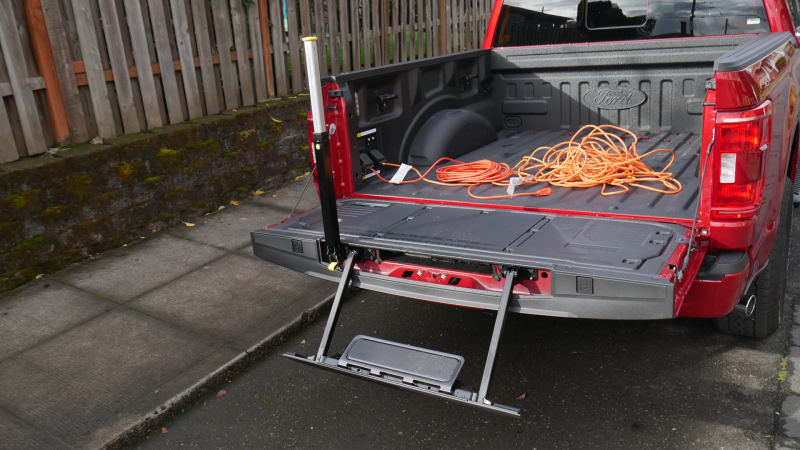
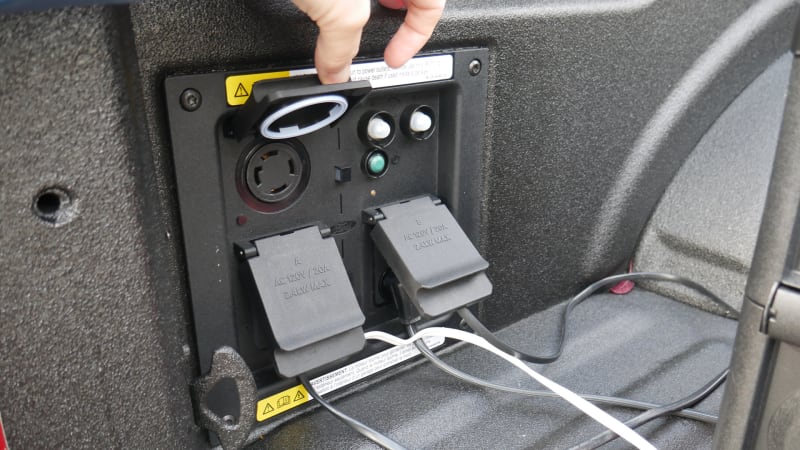
What are the F-150 fuel economy and performance specs?
Settle in, folks, this is going to take a while. The F-150 is back up to seven engine options – the diesel engine from a few years back may still be gone, but the Raptor R adds a supercharged V8. Oh, and we’re not even counting the Lightning, which we review separately.
Every F-150 has a 10-speed automatic and most come standard with rear-wheel drive. The basic four-wheel-drive system has an open diff at the rear, while the upgrade one has an electronic locking rear diff.
The lineup starts with a 3.3-liter naturally aspirated V6 good for 290 horsepower and 265 pound-feet of torque. Fuel economy is a 21 mpg combined with rear-wheel drive, and 20 mpg combined with four-wheel-drive.
Next up is the first of two “EcoBoost” engines, which is just fancy Ford talk for “turbocharged.” The 2.7-liter twin-turbo V6 produces 325 hp and 400 lb-ft of torque, while returning 21 or 22 mpg combined depending on different factors. Don’t be surprised if your real-world fuel economy is much lower than that, however.
There’s still a good-old V8 available: Ford’s 5.0-liter “Coyote” good for 400 hp and 410 lb-ft. Despite its output and cylinder count, it still manages between 18 and 20 mpg combined in regular models, or 17 mpg with the Tremor. Not bad.
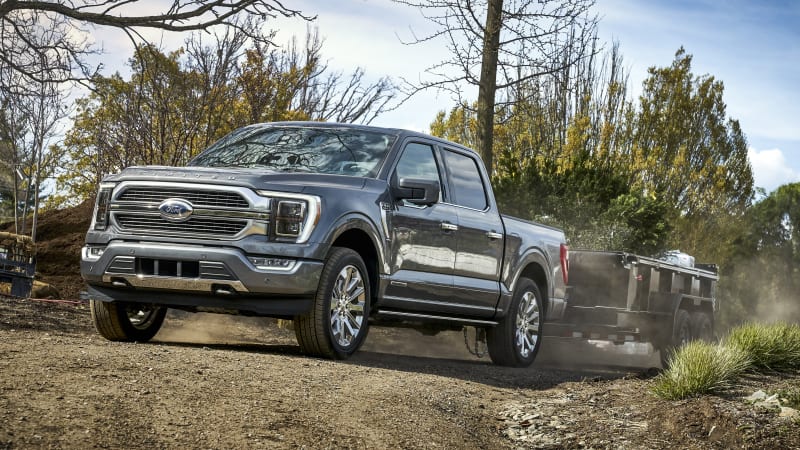
We’d still choose the silky-smooth 3.5-liter EcoBoost V6, though, which pumps out 400 hp and 500 lb-ft of torque. Fuel economy is between 19 and 21 mpg combined depending on drivetrain in regular models, or 18 with the Tremor
The Ford Raptor, meanwhile, now offers a choice in engine. The “base” choice is a upgraded version of that 3.5-liter EcoBoost good for 450 hp and 510 lb-ft. Fuel economy stands at 15 or 16 mpg combined depending on equipment. The new Raptor R boasts a supercharged 5.2-liter V8 from the Mustang Shelby GT500. It produces 700 hp and 640 lb-ft of torque. Fuel economy is only 12 mpg combined, which is just as terrible as the Ram TRX, but hey, it swills regular versus premium so it’ll save you something like $1,000 every year in gas. Value!
Of course, if you’re really interested in saving gas, there’s the sensational PowerBoost hybrid powertrain. Its combination of 3.5-liter twin-turbo V6 and electric motor integrated into the transmission produces 430 hp and 570 lb-ft. It returns 25 mpg with 2WD and 23 mpg with 4WD. That difference may not seem great, but when talking trucks, small differences in MPG figures can actually equate into big savings. In general, though, every version of the 2023 F-150 is impressively efficient for a full-size truck. Well, except the Raptor R.
What’s the F-150 like to drive?
There are so many versions of the F-150, especially in regard to engine choice, that how it drives very much depends. All share one common element: they are shockingly smooth, refined and even responsive to drive. A Platinum test truck and its adaptive steering system was almost SUV-like in the way it moved down the road: the steering was quicker and more responsive than before, the ride smoother, and there was the general feeling of the truck being smaller than it was. The refinement drop off to a much cheaper XLT test truck wasn’t that big, either. For those who need a pickup that can also accommodate the whole family on a road trip, the F-150 is no longer the compromise it once was. The Ram 1500 pulls off a similar trick, and indeed, the gap between the two trucks has narrowed substantially – and has possibly disappeared.
As for those powertrains, we won’t mince words: The F-150 PowerBoost is the most impressive pickup for everyday duty we’ve tested. Its massive output, refined power delivery and superior fuel economy make it the most appealing powertrain option. It also hides its hybridness well – there’s no fussy CVT, awkward brake feel or weird electric noises. It feels totally normal. It also makes the otherwise potent 5.0-liter V8 feel like an old dog, especially in its responsiveness around town. The two EcoBoost turbocharged V6’s are better in this regard, and continue to impress with their buttery smooth power delivery. The bigger 3.5-liter’s substantial output is even more impressive in light of how relatively fuel efficient it remains.
Note that we review the F-150 Lightning separately.
What other Ford F-150 reviews can I read?
2021 Ford F-150 First Drive
We drive as many variations of the new F-150 as we can, but come away most impressed by the PowerBoost hybrid.
2021 Ford F-150 Raptor First Drive Review
We dispatched engineer and off-road expert Dan Edmunds to the California desert to give us the fullest look at the new Raptor you’ll be able to find.
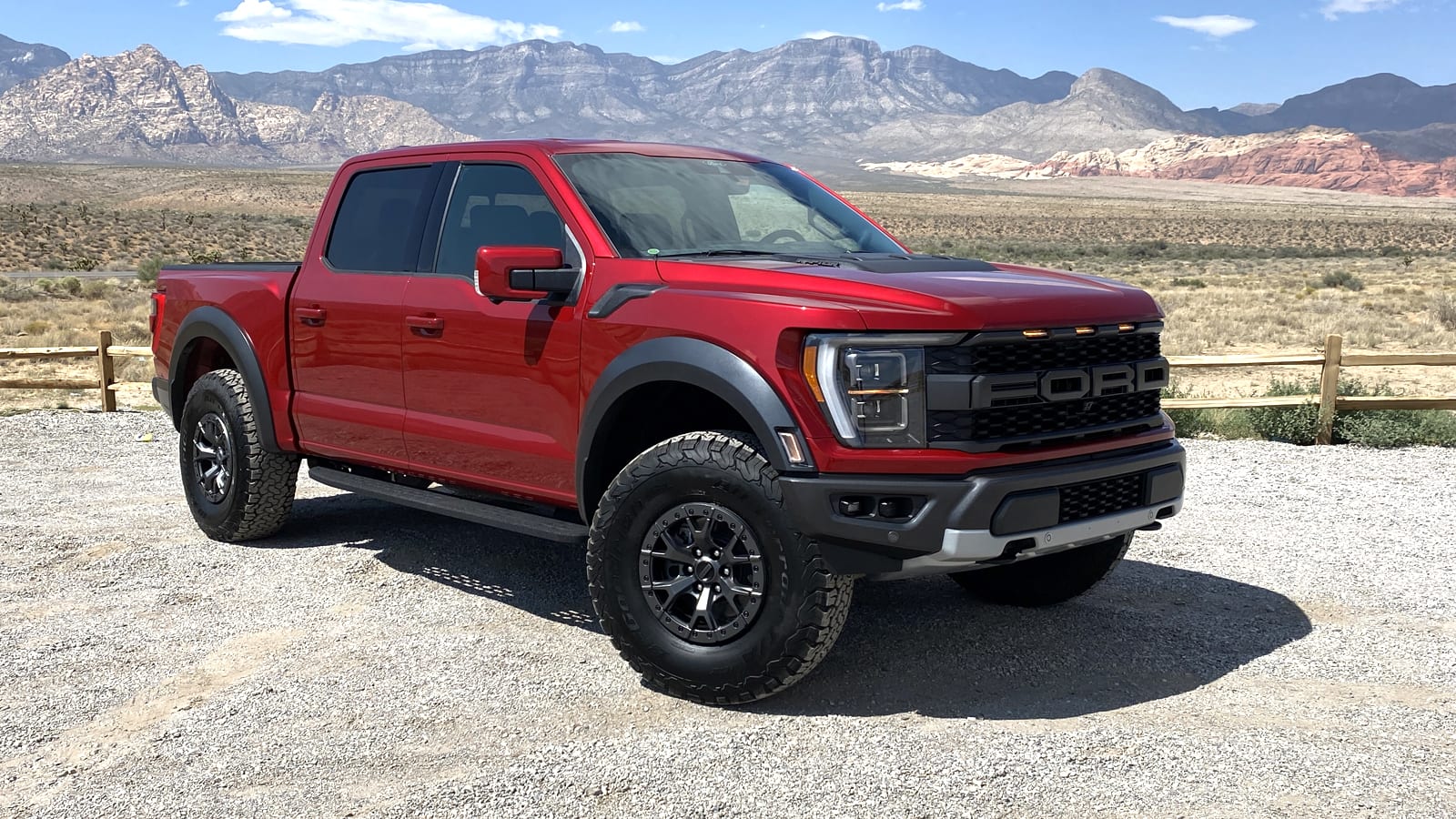
2023 Ford Raptor R First Drive Review: The ‘Big Raptor’ gets the big V8
Detailing what adding a supercharged Shelby V8 does to the Raptor (it does not make it slow)
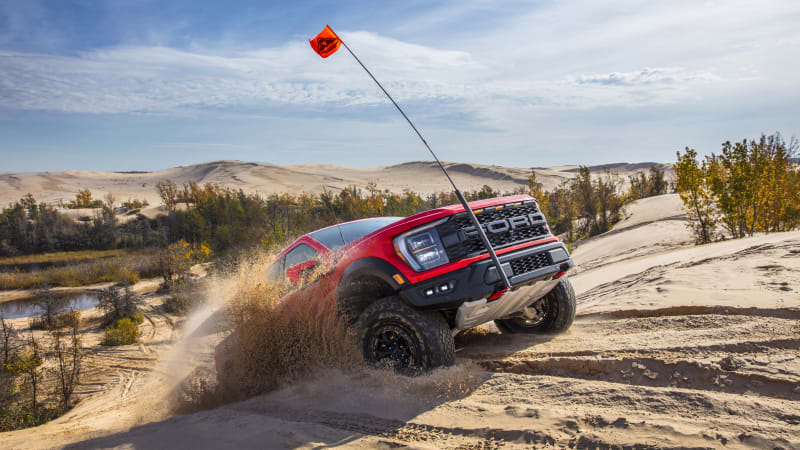
2021 Ford F-150 Tremor First Drive Review
Details about the off-road-oriented Tremor. It’s more a slow-and-steady rock crawler than the Raptor.
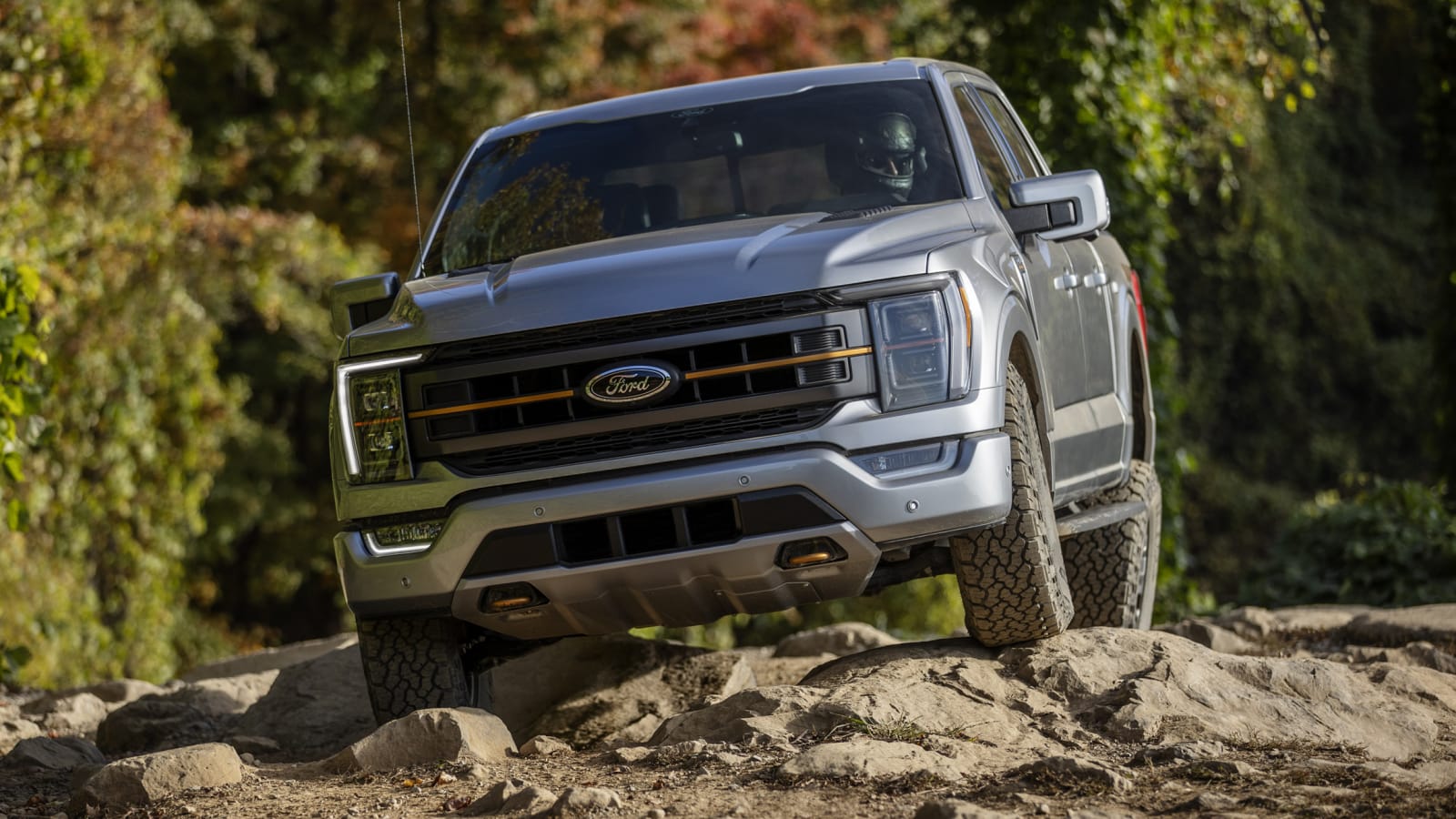
Ford F-150 Lightning Review
Read our detailed review of the Lightning, which is the wildly impressive electric F-150.
2021 Ford F-150 Platinum Driveway Test | Max recline and stay awhile
Join Editor Byron Hurd for a video tour of the F-150’s new interior features.

2021 Ford F-150 Suspension Deep Dive
Ford didn’t draw attention to them, but there are many subtle-but-significant changes.
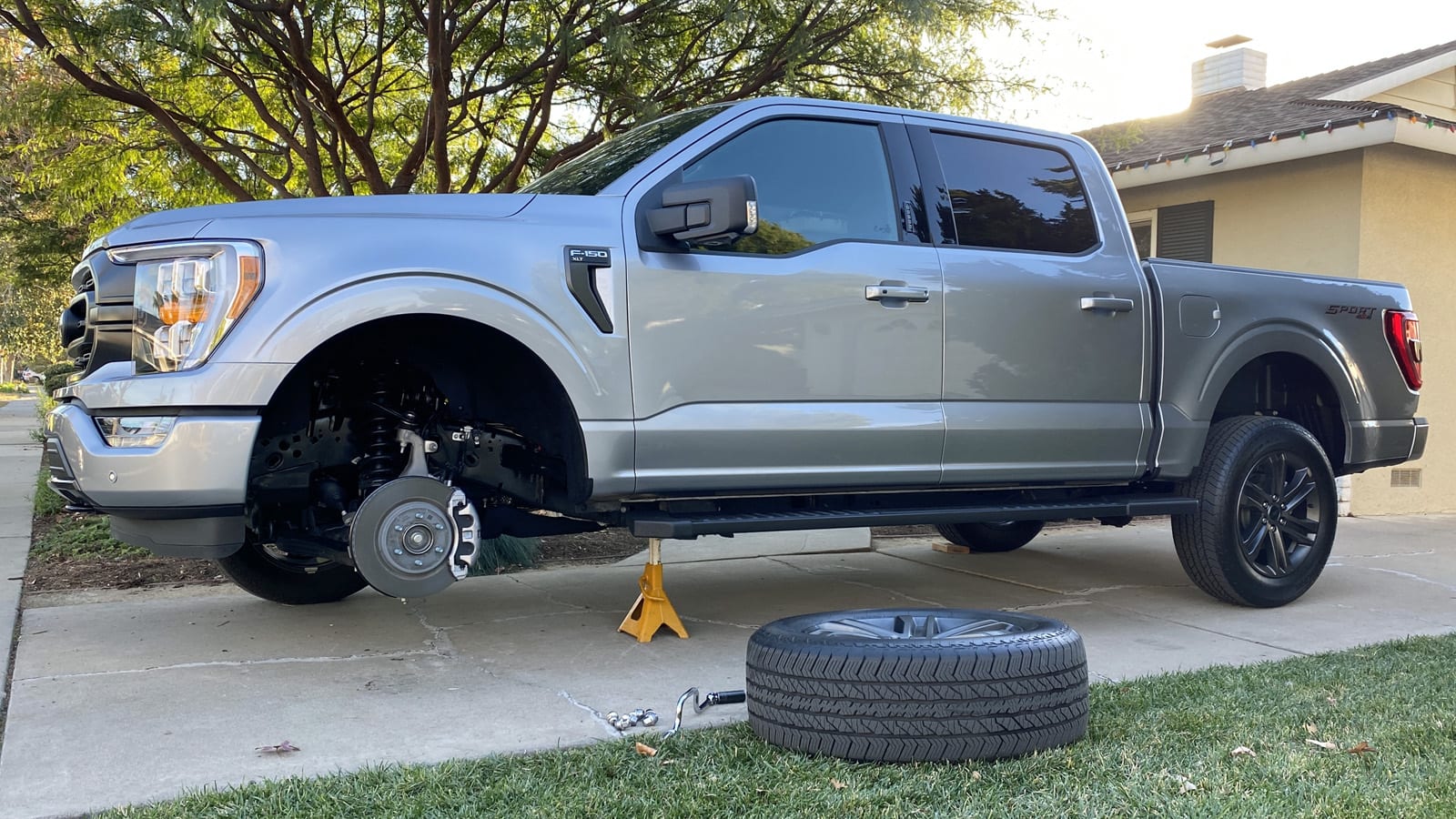
What is the 2023 F-150 price?
Prices are up significantly throughout the F-150 lineup, but the amount differs by trim level. The Lariat has gone up by nearly $8,000, while the XLT and Platinum are only about $1,500 more. Most others are closer to the higher end of that range. All prices below include the hefty destination charge of $1,895.
All prices below are the cheapest price each trim level is available. You can find a more comprehensive rundown of each trim level, including added standard features and the prices of various cab, bed and drivetrain combinations here at Autoblog.
XL: $36,490
XLT: $42,655
Lariat: $59,375
Tremor: $63,005 (pictured below left)
King Ranch: $64,900
Platinum: $66,590
Raptor: $78,670
Limited: $84,910 (pictured below right)
Raptor R: $109,245
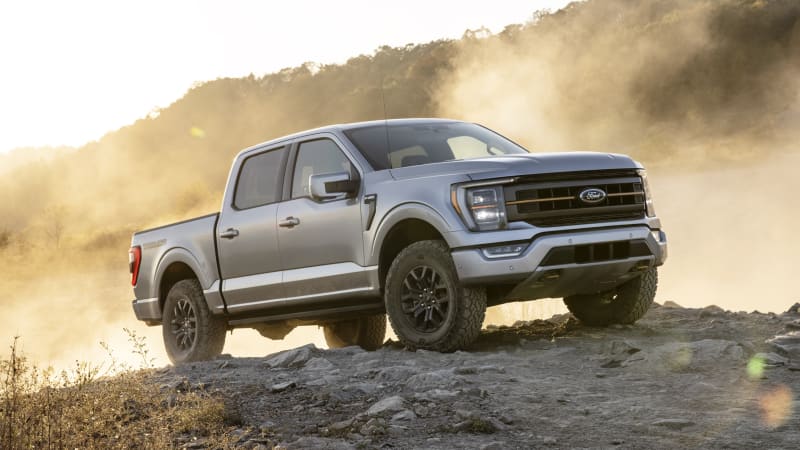
What are the F-150 safety ratings and driver assistance features?
The base XL may not come standard with any driver assist systems, but in general, they are more widely available on the F-150 than on GM or Ram’s trucks. Starting with the XLT, the F-150 comes standard with forward collision warning, automatic emergency braking, lane keeping assist, blind-spot and rear cross-traffic warning and rear parking sensors. It’s also eligible, depending on package or trim level, for the Co-Pilot360 Assist system that adds adaptive cruise control (ACC) with stop-and-go capability, lane-centering steering assist, evasive steering system and speed-sign recognition. The Blue Cruise advanced handsfree driving system can be added to all but the XL and XLT. The standard rearview camera also includes Dynamic Hitch Assist, which provides a sight line to help you hitch up without a spotter (or punching a hole in the bumper).
In government crash tests, every cab style received a perfect five stars for overall, frontal and side crash protection. Insurance Institute for Highway Safety named it a Top Safety Pick for its performance in all relative crash tests and for its crash-prevention technologies. Its headlight ratings were rated Poor, Acceptable and Good depending on trim level and equipment.
Related Video:
[ad_2]
Source link
